Fujian Tourism: A quick look at Xiamen (Photo)
Xiamen, Fujian is one of the most charming cities that reporters have visited more than once. Every time I go there, I can leave too many happy memories. Come to think about it, the most recent trip to Xiamen was an unforgettable experience of visiting Xiamen after the end of the trip to Cebu, Philippines.

Go to Mactan Airport (Photo: Feng Ganyong)
At 15:40 Beijing time on March 23, 2018, the reporter accompanied the Cebu Tour Team in the Philippines. After successfully completing the trip to the Philippines, the reporter took off from Mactan International Airport in Cebu, Philippines. They took Xiamen Airlines Flight MF8004. After two hours and 39 minutes, we successfully arrived at Xiamen Gaoqi Airport.

Xiamen Airport poster (Photo: Feng Ganyong)
Xiamen, Fujian Province, also known as Lu Island, or Lu for short, is an important central city, port and scenic tourist city on the southeast coast. Xiamen is located at the southeastern end of Fujian Province, bordering Zhangzhou in the west, Nan 'an and Jinjiang in the north, and facing the Great and Small Kinmen and Dadan Island across the sea in the southeast. It speaks Minnan dialect. It is the main city in southern Fujian. It is also known as the Xiazhangquan Southern Fujian Golden Triangle Economic Zone together with Zhangzhou and Quanzhou.

Gemini Architectural Landscape (Photo: Feng Ganyong)
As an island city, Xiamen consists of the main island, Gulangyu Island on the outlying island, Haicang Peninsula on the west bank, Jimei Peninsula on the north bank, Xiang 'an Peninsula on the east bank, Daxieng Island, Inland Tong' an, Jiulong River, etc., with a land area of 1,699.39 square kilometers and a sea area of more than 390 square kilometers. In the 21st century, Xiamen has gradually become a modern international port scenic tourism city, with a world cultural heritage and the first batch of national 5A-level tourist attractions-Gulangyu.

Gulangyu Cableway (Photo: Feng Ganyong)
For the city of Xiamen, Fujian, reporters are really too familiar with it. Counting it, since I came to Shanghang, Fujian in May 1999 to shoot the special film "Chinese National Sports-She Nationality" and arrived in Xiamen for the first time, I have followed the China Railway Brigade special train, traveled by car, attended forums, etc. It is my fifth time to visit this city.

Scenery of Xiamen (Photo: Feng Ganyong)
I remember when I first went to Gulangyu, the ferry ticket for a boat crossing the sea was only 2 yuan. However, when I arrived in Xiamen and took a taxi from the hotel to Zhongshan Road, I heard from the taxi driver that it had now increased to 35 yuan. The supply was still in short supply, and you needed to book in advance to go. No wonder there were no trips to Gulangyu in the one-day trip to Xiamen organized by the team. Although it is unbelievable that this kind of change is such a great speed, it reflects the popularity of Xiamen's tourism from one aspect.
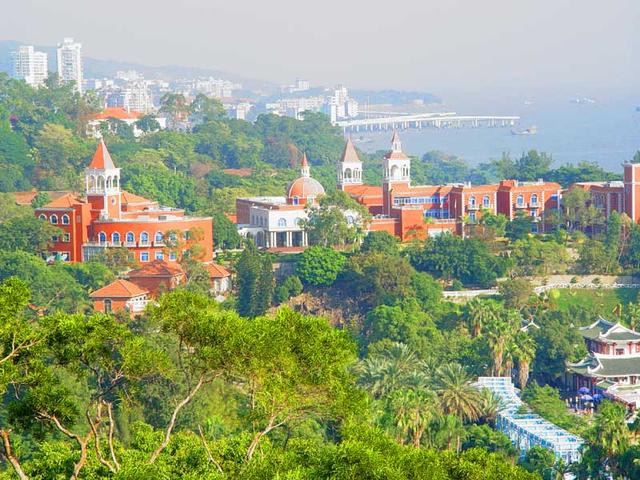
Scenery of Xiamen Ludao (Photo: Feng Ganyong)
It was a special coincidence that just the day before the reporter arrived in Xiamen, my daughter came here to participate in a "yoga festival" activity. She had just arrived here and agreed to meet together on Zhongshan Road near her daughter's hotel in Xiamen that evening, and have dinner together. This extremely low probability coincidence also contributed to a trip to Xiamen for the reporter's family.

Photo taken at the reunion of Zhongshan Road (Photo: Lu Ren)
This rare "three-person world" small gathering in Xiamen is really something that is rare and rare in life. Although the time is short, it allows the reporter family to experience the feeling of family happiness. Shopping, shopping, and dining, all of which left an extremely unforgettable and beautiful aftertaste of life...

Night on Zhongshan Road (Photo: Feng Ganyong)
Take a taxi to Zhongshan Road Pedestrian Street. I saw that it was very lively and bustling here. It is said that it is the oldest commercial street in Xiamen, with a large number of people, a lot of goods, and a great reputation. Whether in the past or today, when people mention Xiamen, they will always talk about Zhongshan Road, just like Manhattan in New York, Ginza in Tokyo, and Central in Hong Kong. When people come to Xiamen, they must come here because it represents Xiamen's prosperity, wealth and rhythm of the times. You can enjoy the rich material world and appreciate the modern style here. Zhongshan Road is the pride of Xiamen people!
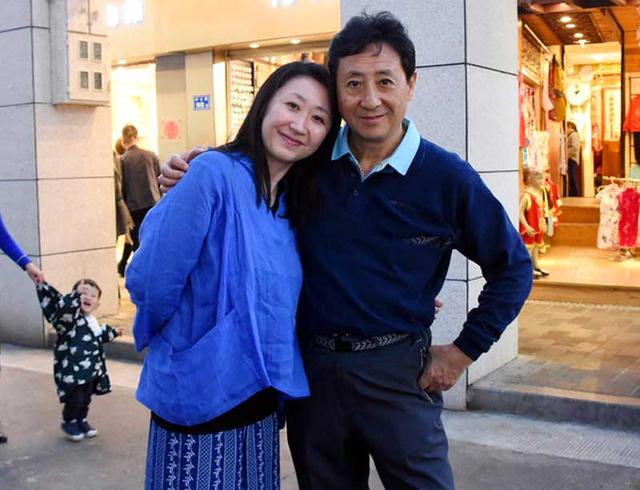
Taking a photo with his daughter on Zhongshan Road (Photo: Wang Jue)
Today's Zhongshan Road in Xiamen is an old city district that has been relatively preserved and shows modern historical features. It has many cultural monuments such as Xiaozouma Road, Chen Huacheng's former residence, and the First Holy Hall of China. The Nanyang Arcade Building, the dazzling LED night view, the dazzling array of Fujian and Taiwan specialty snacks, and the ancient Nanyin echoing in the alleys and neighborhoods constitute its distinctive style. In June 2012, Xiamen Zhongshan Road was successfully awarded the title of "Famous Historical and Cultural Street in China".

Photo taken by mother and daughter at dinner (Photo: Feng Ganyong)
After the family reunited, they began to wander Zhongshan Road before sunset. Not long after, Zhongshan Road, where the lights were first on, was crowded with people and bright lights. It was really a bustling scene of a lively southern city. She met with her daughter for dinner at the old Xiamen private kitchen, a time-honored Chinese brand located in the central area of Zhongshan Road.

Leave a beautiful moment (Photo: Feng Ganyong)
During a pleasant chat, dishes were served on the table one after another. Four dishes, including yellow croaker boiled noodle line, Xiamen Port soju snails, crispy taro duck, shrimp and sweet potato leaves, are all specialties recommended by the store. Especially the dish of yellow croaker boiled noodle line. The reporter glanced at it casually and saw that basically all the customers entering the store had chosen it. Each taste has its own characteristics. The boiled noodle line is really fresh, but the crispy taro duck is a bit greasy. The soju snails were basically covered by her daughter alone.

Nanputuo Temple (Photo: Feng Ganyong)
2018.03.24 At 07:30 Beijing time, the Cebu Tour Team in the Philippines officially started the final journey of a one-day trip to Xiamen, Fujian after returning home. After leaving the hotel, we first came to Nanputuo Temple to pay homage. This is the third time that reporters have visited this famous temple in the south.

Nanputuo Temple lintel (Photo: Feng Ganyong)
Nanputuo Temple is located at the foot of Wulao Peak in the southeast of Xiamen City, Fujian Province. The temple facing Bicheng Harbor covers an area of 258,000 square meters and a building area of 21,270 square meters. Nanputuo Temple was built in the late Tang Dynasty and was called Sizhou Temple. During the Zhiping period of the Song Dynasty, it was renamed Puzhao Temple. In the early years of the Ming Dynasty, the temple was deserted and was not rebuilt until the Kangxi period of the Qing Dynasty. Because it worships Guanyin Bodhisattva, it is similar to the Guanyin Dojo in Putuo Mountain, Zhejiang, and is located south of Putuo Mountain, so it is named "Nanputuo Temple".

The Buddhist characters in the temple (Photo: Feng Ganyong)
Nanpuyuan Temple faces north and south. It is built next to mountains and sea. It is large in scale and solemn in momentum. The main buildings along the central axis are the Tianwang Hall, the Daxiong Bao Hall, the Ledu Hall, the Great Compassion Hall, and the Sutra Pavilion. Among them, the Tianwang Hall is located at the front end of the central axis of the temple. The smiling Maitreya Buddha is enshrined in the middle of the front hall. There are four big heavenly kings looking around on both sides. Behind the hall, Weituo Bodhisattva stands with his palms pressed against the pestle, making it extremely powerful. The Dian Pavilion rises layer by layer against the mountain, with clear layers and corresponding pitches. The corridors rising in turn on the east and west sides protect both sides of the three halls, making them a whole.

Photo taken at Nanputuo Temple (Photo: Zhao Huilan)
The Daxiong Hall is the center of the entire temple and has the characteristics of a typical Buddhist hall in southern Fujian. The center of the hall is dedicated to a tall statue of the Three World Honored Buddha, and the back of the hall is dedicated to the Three Western Saints. The Hall of Great Compassion has an octagonal shape with triple flying eaves, and the middle caisson is made of stacked arches layer by layer. There is no nail and the structure is extremely exquisite. The center of the hall is dedicated to Guanyin Bodhisattva, and the other sides are 48-armed Guanyin, which is beautiful in shape and diverse in postures. Because all believers in southern Fujian worship Guanyin Bodhisattva, the incense in this hall is extremely prosperous.

Flower scenery in the temple (Photo: Feng Ganyong)
There is a square in front of the Tianwang Hall. In front of the square are a square release pond with a length of about 30 meters in length and width, and a lotus pond with a length of about 100 meters and a width of 70 meters. The lotus pond is covered with a low wall with a glazed tile roof, and there are symmetrical double-eaves archways in the east and west. The title is "Famous Mountain on Ludao", which was written by Zhao Puchu, former president of the Chinese Buddhist Society.

Release lotus flowers in the pond (Photo: Feng Ganyong)
All buildings in the temple adopt ancient palace-style large roofs with double eaves and flying ridges, decorated with apricot yellow glazed tiles to make them unified and coordinated. The entire temple complex is then surrounded by stone walls, like scattered beads supporting the plate, forming a whole. The Sutra Pavilion is the highest-story building on the central axis. It is a double-decked pavilion with double eaves on Xieshan. The first floor is a Dharma Hall, where monks teach scriptures. The second floor is a Jade Buddha Hall, which houses 28 Burmese Jade Buddhas. It also contains tens of thousands of volumes of Buddhist scriptures, ancient and modern, Chinese and foreign scriptures and some precious cultural relics.

A pious layman (Photo: Feng Ganyong)
Maybe it was Saturday, and there were so many tourists coming here, and there were people everywhere inside and outside the temple. At this time, I happened to see many laymen entering the temple in a long queue. Everyone's solemn and solemn expressions formed a clear gap between them and ordinary tourists, reflecting the unique atmosphere of the Buddhist holy land from one aspect.

Xiamen University Campus (Photo: Feng Ganyong)
The second stop of the one-day tour in Xiamen is to visit Xiamen University. After tourists come out of the Nanputuo Temple Gate, diagonally opposite the south gate of Xiamen University is the south gate of Xiamen University. The place where the two are so close to each other can be said to be an inevitable itinerary for anyone visiting Xiamen. Visiting Xiamen University, an institution of higher learning, is also the third time that reporters have visited it.

Photo taken by Xiamen University (Photo: Feng Ganyong)
Xiamen University, a university founded in 1921 by Mr. Chen Jiageng, a famous patriotic overseas Chinese leader, was the first university founded by overseas Chinese in the history of modern education in China. It was one of the earliest universities in China to recruit graduate students and was known as the "strong country in the south". Most of the old buildings on campus were built by Mr. Tan Jiageng's son-in-law. They have clear water walls and glazed roofs, which are very distinctive and are described as "wearing a suit and wearing a bamboo hat", which is used to describe the perfect combination of Chinese and Western architectural styles. Especially the Jiannan Auditorium and the winding field, which are quite magnificent. There are the Xiamen University Museum of Humanity and Lu Xun Memorial Hall on campus. Xiamen University is known as "the most beautiful campus in China", and its unique architectural style combining Chinese and Western is the biggest attraction.

Sculptures by the lake (Photo: Feng Ganyong)
The former collects cultural relics about mankind and its development from prehistoric to modern times, especially cultural relics reflecting the culture of southern Fujian and Taiwan, as well as ancient Fujian's exchanges with foreign countries, especially the historical sites of Quanzhou's overseas transportation, etc., which are very unique and valuable. Lu Xun Memorial Hall displays Mr. Lu Xun's life experience and respectable personality with Lu Xun's former residence and four showrooms while he was teaching at Xiamen University.
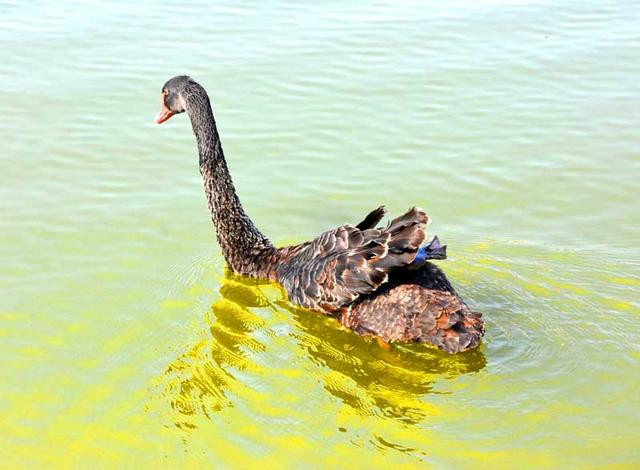
Swan in Furong Lake (Photo: Feng Ganyong)
Walking into Xiamen University, I saw that the campus scenery in people's eyes is very beautiful, including scenic spots such as Furong Lake and Lovers Valley Reservoir. The atmosphere is quiet and romantic, so there is a saying that "love is at Xiamen University". The study and living scenes of students and monks form a unique world-view of the Xiamen University campus and its surrounding areas, which cannot be seen anywhere else.
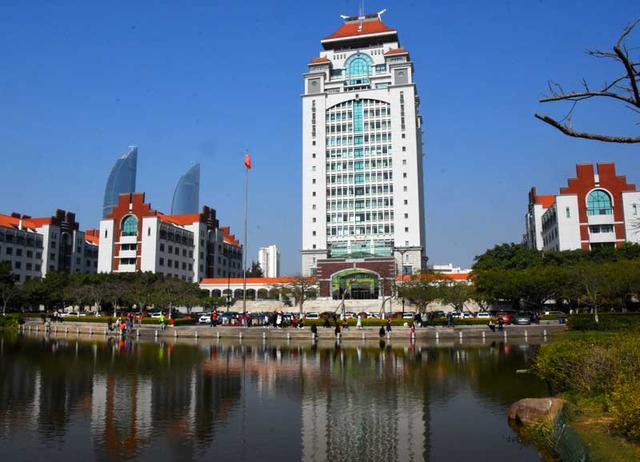
Song 'en Building, Xiamen University (Photo: Feng Ganyong)
The Xiamen University campus itself is a famous scenic spot in Xiamen. The scenic and tourist areas in Xiamen urban area basically radiate from Xiamen University. There is the Kelilou International Academic Conference and Exchange Center 100 meters away from the south gate of Xiamen University; and the south gate of the campus is the terminal for multiple buses. Climbing the hill and passing through the tunnel, you will reach the seaside area of the school. It is close to the sea. After the school gate, you will find the famous Xiamen Huli Mountain Battery and the coastal East Ring Road. It is connected by a series of characteristic attractions and faces Kinmen across the sea. Because the campus area is too large, the reporter went to Furong Lake and Song 'en Building to enjoy it and then walked back as usual.
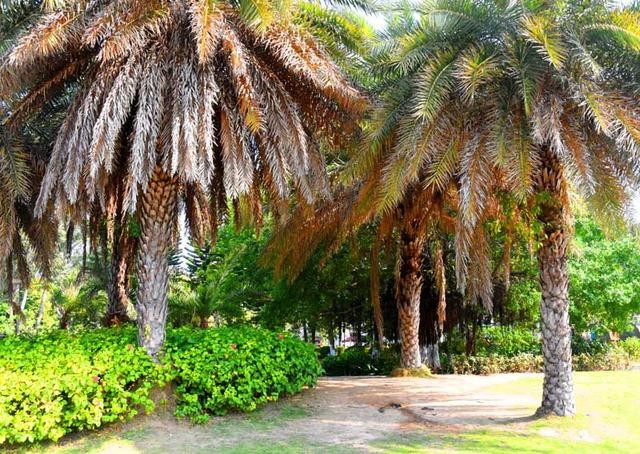
Coconut tree style (Photo: Feng Ganyong)
The third stop of the one-day tour in Xiamen is Zengcuo 'an Fishing Village. Although the reporter has visited Xiamen many times, Zeng Cuo 'an has visited for the first time. This place is known as the most literary and artistic fishing village in China and is the abbreviation of "Zengcuo 'an Cultural and Creative Village". Also known as "Zengli", also known as "Zengwo" and "Zengjiawan", is located in the southeast of Xiamen Island. It has the grass of Tuerling, the stone of Taimu Mountain, and the reef of volcanic island, integrating nature and humanity. It has a history of more than 800 years.

Zeng Cuo 'an Gate (Photo: Feng Ganyong)
Zengcuo 'an borders Huangcuo on the east, Baishi Fort on the west, Hulishan Fort on the west, Huandao Road on the south, facing Dadan Island across the sea, and Guling on the west of Yuping Mountain in the north. It is surrounded by mountains on three sides and faces the sea on one side, covering an area of about 6.5 square kilometers and beautiful scenery. There is no hustle and bustle of Gulangyu Island or the prosperity of the urban area. There are only simple residential buildings and small, artistic and fresh storefronts. Of course, there are also non-chaotic bars and a large number of snacks.

Walking into Zeng Cuo 'an (Photo: Feng Ganyong)
With the crowded tide of people, walking through the streets and alleys of Zengcuo 'an, I saw that whether it is the red brick ancient house or the Nanyang-style "Fanzai Building", it is written with the legacy of overseas Chinese, and the iron flowers and tiles that can be seen everywhere also add a feeling here. Of course, there are also personalized small shops, quiet bars, and authentic small restaurants; the most important thing is that there are a group of extremely lovely people here, who are literary and artistic, who love to play, who like to travel, who like to take photos, and who like to make friends.

Temple in Zeng Cuo 'an (Photo: Feng Ganyong)
Zeng Cuo 'an, a small fishing village in southern Fujian, was the berth for commercial ships at Haicheng Moon Port during the Ming Dynasty. Ships heading overseas from Haicheng had to go to Xiamen for inspection and docked at Zeng Cuo' an to avoid the wind and wait for news. The dialect "Wo" refers to the bay for ships, and "bay" refers to the entry and exit of boats from the port. The Huli Mountain Fort of Huli Mountain Society in Zengcuo 'an is the fortress of Xiamen Port. It was built in the 16th year of Guangxu of the Qing Dynasty (1891 AD). Navy was stationed in the Qing Dynasty. The existing Krupp cannons are the largest in the world. Zengcuo 'an Village After the Revolution of 1911, the Kuomintang established a "Naval Aviation Department" and an airport in Zengcuo' an.

European architecture (Photo: Feng Ganyong)
Historically, Zeng Cuo 'an has always existed as a rural area. People there make a living by fishing and renting out houses. The villagers of Zengcuo 'an "men fishermen and women farm, men go out to fish, and women stay at home to farm the fields and take care of their children. The formation of fishing villages is probably due to the mountains and the sea. Backed by the mountains and facing the sea, life in the fishing village was free and comfortable at first.

Hot food stalls (Photo: Feng Ganyong)
In the early 1990s, the Zengcuo 'an people still liked to talk about the Anti-Japanese War and the cross-strait confrontation. After the Japanese landed from Wutong, they carried out a cruel massacre in Zengcuo 'an Village, which is still a painful memory that cannot be erased in the hearts of the old people. The story of the period of cross-strait confrontation seems a bit ridiculous: farmers were working by the seaside when a bomb flew over and stopped at their feet. Fortunately, they escaped. If they were unlucky, they would "die heroically". Although it is bizarre, it is true when it comes from the mouth of the people of Zengcuo 'an.

Beautiful girls taste delicious food (Photo: Feng Ganyong)
Zeng Cuo 'an's anecdotes are by no means heavy. In 1929, Zeng Cuo' an Airport welcomed the landing of "Chen Wenlin, China's first pilot to fly across Eurasia alone." Chen Wenlin's "Xiamen" plane took off from London, traveled more than a dozen countries in Europe and Asia, traveled more than 15,000 kilometers, and arrived in Xiamen on May 12. This incident became a hot topic in media at home and abroad, not to mention the villagers of Zengcuo 'an who witnessed this historical moment with their own eyes.

Foreigners also join cake shops (Photo: Feng Ganyong)
Time is like songs and past events are like smoke. Now everything here is undergoing profound changes. Zengcuo 'an has been included in the scope of Urban area reconstruction and is planned to be built into a cultural and educational, recuperation, tourism, and residential area on the southeast coast of Xiamen, and will build resettlement houses, regional municipal roads, public building facilities, and centralized greening landscapes. The years of Zeng Cuo 'an's natural village can only be left in people's memories.

Special flavors (Photo: Feng Ganyong)
Zengcuo 'an is not far from the seaside. It is said that it takes about five minutes to walk to the seaside of Xiamen. The sea breeze, sandy beaches, beautiful women, sea water and blue sky are all in front of people. There are no constraints here, only the simplest return; If people happen to catch a certain festival here occasionally, they will see a wonderful folk customs, because this is a diversified life.

Hot Snack Alley (Photo: Feng Ganyong)
As a scenic spot, Zengcuo 'an Wenchuang Village only accounts for 0.33 square kilometers. Nowadays, walking into this fishing village is like a popular snack street. I saw that it was crowded with people, with food shops and craft shops lined up one after another. The noisy cries rushed into the ears of tourists, making people feel more lively.

Xiamen Seaview (Photo: Feng Ganyong)
With the end of sightseeing in Zengcuo 'an in Xiamen, the Cebu trip in the Philippines came to a successful conclusion. The team arrived at Xiamen Gaoqi Airport under the guidance of Xiamen tour guide Xiao Lin and team leader Fan Yu. They took Xiamen Airlines flight MF8159 and took more than an hour. The flight arrived at Putuoshan Airport in Zhoushan, Zhejiang Province for a short stopover. After that, they successfully arrived at Terminal T2 of Capital Airport at 22:51 Beijing time that night. At this point, the eight-day trip to Cebu, Philippines, came to a successful conclusion as the team arrived in Beijing. (Photo and text: Feng Ganyong)
Previous Article:Xiamen Frozen Christmas and New Year's Eve is the ultimate way to play
Next Article:Xiamen Xiaodeng Island for two days and one night, experience the game life between fishermen and the sea
